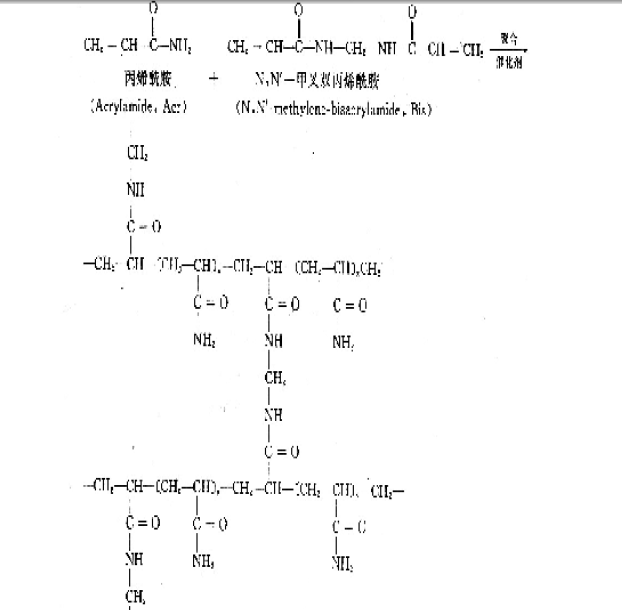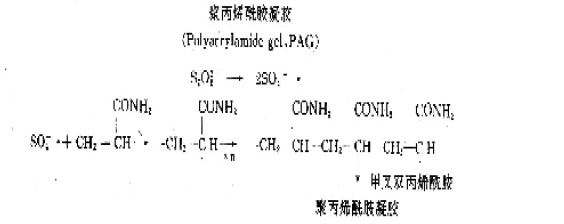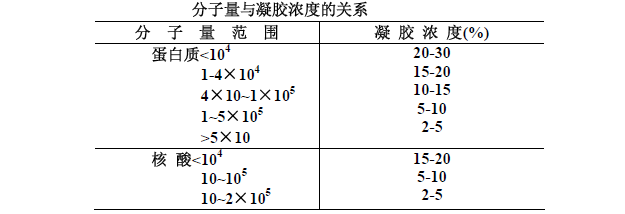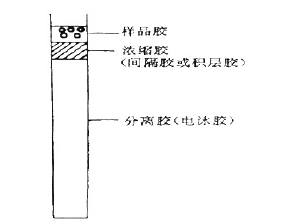1. Synthesis and structure of polyacrylamide
Polyacrylamide gel is acrylamide (Acrylamide abbreviated as Acr) and cross-linking agent dimethyl bisacrylamide (N, N1-methylene-bisacrylamide (abbreviated Bis) under the action of a catalyst, polymerized and crosslinked to form an amide group side A chain of aliphatic macromolecular compounds. Shanghai Chuangsai Technology provides 110-26-9, methyl bisacrylamide, N, N'-Methylenebisacrylamide, high purity, 99%, commodity number: D23-S14002-100g, price 158 yuan.
There are two systems available for the catalyst.
(1) A system of ammonium persulfate-N-Tetramethyl-ethylene diamine (TEMED) in which ammonium persulfate is an initiator. It is cleaved by light irradiation into ammonium sulfate with free radicals, and the acrylamide becomes a free radical by the transfer of free radicals to initiate polymerization. TEMED is an accelerator that speeds up the release of free radicals by the initiator.


(NH4)2S2O8→→→→→(NH4)2SO4
(2) Riboflavin-TEMED system, in which riboflavin is an initiator and TEMED is an accelerator. This catalyst system requires strong light and a small amount of oxygen. Shanghai Chuangsai Technology provides 83-88-5, riboflavin, Riboflavine, 98%, commodity number: C16-R10027-100g, price 395 yuan.
The polyacrylamide gel has a three-dimensional network structure and can function as a molecular sieve. Using it as an electrophoresis support, the separation of the sample depends not only on the amount of charge carried by each component, but also on the size of the molecule. The size of the gel mesh is mainly affected by the total concentration of the gelatin and the ratio of Acr and Bis. In general, the electrophoresis uses a total concentration of 7.5% of the gelatinous substance. This concentration is called the standard gel concentration. If the total gel concentration is changed, the ratio of Acr to Bis should also be changed accordingly.
When the total gel concentration is 5% or less, Acr:Bis is about 20.
When the total gel concentration is 5~10%, Acr:Bis is about 40.
When the total gel concentration is 5~20%, Acr:Bis is about 125~200.
In the experiment, the appropriate total gel concentration and the ratio of Acr and Bis should be selected according to the molecular weight.

2. The basic principle of discontinuous polyacrylamide gel electrophoresis
Discontinuous polyacrylamide gel electrophoresis is electrophoresis performed under conditions of a medium buffer composition of a polyacrylamide gel support, a buffer pH, a gel pore size, and a potential gradient discontinuity. Discontinuous polyacrylamide gel electrophoresis has a higher resolution. This is because there are not only charge effects and molecular sieve effects (present in the separation gel), but also a unique concentration effect. The following is a brief introduction to the basic principles of discontinuous disk electrophoresis:
(1) Concentration effect
Discontinuous disk electrophoresis is generally carried out in small glass tubes. Three polyacrylamide gels of different properties are overlapped. As shown in Figure 4-3, the upper layer is the sample gel and the middle is the concentrated gel. The gel concentration of these two layers of gel is 3% is macroporous gel, and Tris-HCl buffer is used, its pH is 6.7. The lower layer is the separation gel. The total gel concentration of this layer is 7.5%. It is a small pore gel and also uses Tris-HCl buffer, pH 8.9. The upper and lower electrode tank buffers were Tris-glycine buffer, pH = 8.3. After energization, there are three kinds of anions that migrate toward the anode, namely Cl -, protein anions (Pr -) and glycine anions (Gly -). In the environment where the sample gel and the concentrated gel pH=6.7, HCl is completely ionized to Cl-, and only a very small portion of glycine is ionized to Gly- (glycine pI=6.0), and the acidic protein is also dissociated into an anion. Thus, Cl - the fastest movement (called fast ions), Gly - the slowest movement (called slow ions), protein between them. After energization, the fast ions quickly surpass the protein ions and Gly- and move to the front. Thus, a region of low ion concentration is formed between the fast and slow ions, that is, a low conductance region, and the low conductance region has a high voltage gradient. The voltage gradient drives slow ion acceleration. Thus, when the fast and slow ion moving speeds are equal, an interface that constantly moves toward the anode is established. The swimming speed of Pr – is just between the fast and slow ions. Thus squeezed to form a narrow band between the fast and slow ions. This concentration allows the protein to be concentrated hundreds of times. Serum proteins can only be divided into 5-7 components on paper electrophoresis and cellulose acetate membrane electrophoresis. On polyacrylamide gel electrophoresis, it can be divided into 20-30 components.

(2) Charge effect
Protein samples are concentrated at the interface into a narrow, high-concentration protein region, but because each protein molecule has a different effective charge, the mobility is different, so the various proteins are arranged in a circle in the order of the rate of migration. Panel belt. The charge effect still works when entering the separation gel.
(3) Molecular sieve effect
When the concentrated protein sample enters the separation gel from the concentrated gel, the pH and gel pore size change abruptly, and the pH value of the separation gel is selected to be close to the Pka value of glycine (9.7-9.8), so that the dissociation degree of the slow ion increases. Therefore, its effective migration rate also increases. At this point, the effective mobility of slow ions exceeds the effective mobility of all proteins. Thus, the high potential gradient does not exist, and the various proteins will only be different in their degree of retardation depending on their molecular weight or configuration, under a uniform potential gradient and pH, depending on their separation through a certain pore size. , showing different mobilities and being separated. Shanghai Chuangsai Technology provides 4530-20-5, tert-butoxycarbonyl-L-glycine, ≥98.5%, commodity number: D16-1000956-25g, price 204 yuan.
Shanghai Chuangsai Technology has excellent performance, interleukin cytokines, fetal bovine serum, electrophoresis equipment scientific instruments, raw material drug standards, chemical reagents, cell culture consumables, Shanghai Chuangsai, mass products special promotions, welcome to inquire!
Polyester Work Wear
1.Environmental protection, non-toxic, harmless and pollution-free
2.Long-lasting plasticity, recyclable
3.Does not deform or fade
4.Anti-UV and fire resistant
5.Good low temperature flexibility
6.Effectively resistant to harmful chemicals and industrial pollutants
7.The seam is formed by hot air welding, which is firm and reliable, and has long-term weld ability.
8.Smooth surface, not easy to stain, no need to clean
Polyester Rainwear,Polyester Work Wear,Polyester Raincoat,Polyester Suit Jacket
Jinzhou City Hejin Clothing CO.,Ltd , https://www.hejin-cloth.com